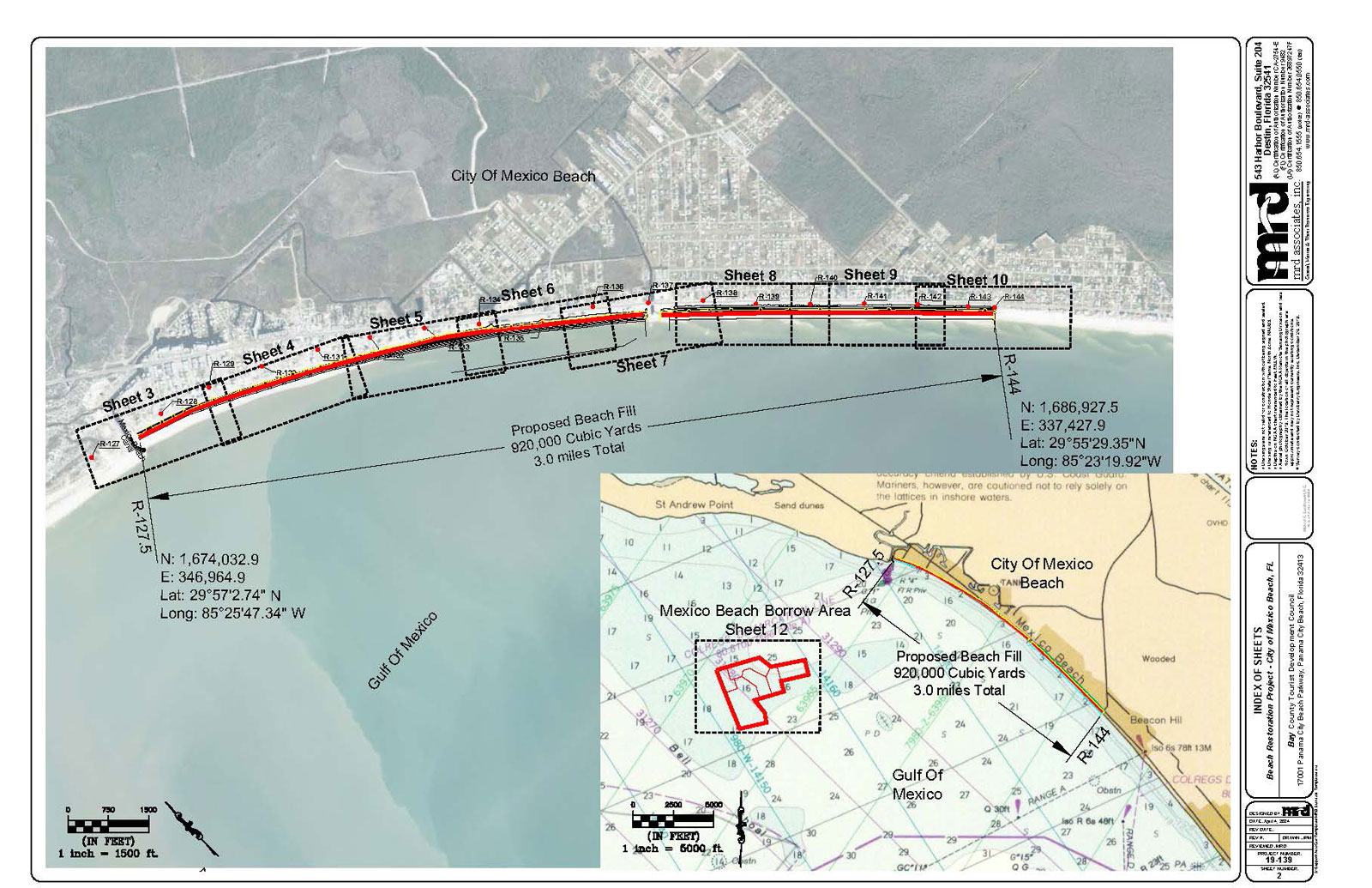Beach Restoration
The first full-scale beach nourishment of the Mexico Beach shoreline will be under construction sometime late this fall 2024/winter 2025, with an anticipated completion by May 1st, 2025. This is a very important storm protection project for Mexico Beach that has taken years of hard work and planning to make happen! In fact, the Mexico Beach Community Development Council began work on this project prior to the devastation caused by Hurricane Michael. The following questions and answers provide many of the details about the project and will be continually updated.
Q: Where is this project taking place?
The beach nourishment project will cover the entire approximate three-mile City of Mexico Beach shoreline from the Mexico Beach Canal at the western end to the Gulf County line at the eastern end. The project will consist of both dry sandy beach berm and dune construction.
Q: Why is this project important?
This project is first and foremost a shore protection project intended to provide critical storm protection for public and private infrastructure, structures, and property upland of the beach. While storm protection is the priority, the project will also provide additional recreational beach width for the benefit of residents and visitors as well as habitat for several species such as shorebirds and sea turtles.
Q: How much sand is being placed as part of this project and how wide will the beach be?
Nearly one million cubic yards of sand will be placed with this first full-scale beach restoration project for the Mexico Beach shoreline. The project consists of a dune-only component on the west end of the beach and then transitions to a dune and beach berm around 34th street all the way to the Gulf County line. The beach berm will be extended approximately 175 feet from the seaward toe of the proposed dune.
Q: How long will this project take to construct?
The project is expected to take approximately 3 months; however, construction may move faster or slower. There may also be circumstances that cause lengthy delays due to construction shutdown, like weather conditions or major repairs to equipment, so please keep checking the Construction Schedule.
Q: What is the project construction schedule?
The order of work will be finalized by the contractor and Bay County prior to construction. We will not have an order of work or an idea of how quickly the project will advance along the beach until a contractor has been selected. Please monitor the Construction Schedule for further details on the schedule as it becomes available. This Construction Schedule will be updated at least every seven days once construction commences. Construction plans have been released. Please note that these plans are not signed nor sealed as this will occur once the bidding has been finalized.
Construction Plans- Beach Restoration Project
Q: Who is managing this project?
The Bay County Tourist Development Council, the Mexico Beach Community Development Council and Bay County will be managing the construction of the project in coordination with the City of Mexico Beach.
Q: Who is the dredging contractor?
Once the project bidding is complete and a contract is awarded, the dredging contractor will be announced.
Q: Where is the sand coming from that is being placed on the beach?
The sand for large-scale beach nourishment projects comes from our permitted, offshore “borrow area.” The Mexico Beach borrow area is located approximately three miles offshore of Mexico Beach.
Q: How does the sand get to the beach?
The sand is dredged from the offshore borrow areas via a cutter or hopper type dredge. The dredge attaches to a submerged pipeline, which lays on the seabed and comes up onto the beach, which then runs parallel to the shoreline. The sand is discharged as a water and sand slurry mixture through the pipeline. The sand stays on the beach, and the water runs back into the Gulf of Mexico. Bulldozers reshape the newly discharged sand to meet the designed construction template.
Q: Why does the sand coming out of the pipe look darker than the sand on the beach?
The sand coming out of the pipe is a water and sand slurry mixture, and it often contains darker, fine material that washes out as the sand is reshaped on the beach by the bulldozers and dries out over time. This is not contamination. There is a detailed Quality Assurance/Quality Control plan in place that will immediately address any sand quality issues that may arise.
Q: How fast does the project move down the beach? How long will it be in front of my property?
Construction should progress at a rate of 250 feet to 1,000 feet per day. Barring any temporary work stoppages, this means the active construction area may only be in front of your property for a couple days, but that could be longer. Please be patient. Everyone, including the contractor, engineers, and the Bay County TDC, Mexico Beach CDC, and Bay County wants the project to continue moving down the beach and closer to completion as quickly and safely as possible.
Q: How do I access the beach when construction is occurring in front of my property? How do I get over the dredge pipe?
The active work/construction area is limited to an approximate 1,000 to 2,500-foot sections of beach. Walk laterally along the beach until you get around the active work area, locate a sand bridge that goes over the dredge pipe, and you will be able to access the Gulf. The contractor will build sand bridges over the dredge pipe, which is laid laterally along the shoreline, so that pedestrians may have access to the Gulf.
Q: What are the work hours for construction and is it noisy?
Unless the work temporarily ceases for repair or weather, work will continue 24 hours a day. Bulldozers, front-end loaders, and other large pieces of equipment will be used in the construction of the beach project and can be noisy. These are extremely expensive projects, and it is not feasible to halt work overnight or on weekends.
Q: Can I still rent out my home/condo during construction?
Like many other beach communities such as Panama City Beach, during construction of a beach project, renters and owners still enjoy the beach and typical vacation activities during construction. Some safety restrictions around the “active construction” site will limit access to the public but as noted above, the beach will remain open, and the “active construction” site will move down the beach. However, we cannot predict where and when the crews will be working and if it will impact your property during a given week. As noted above, the construction schedule will be updated at least every seven days once construction commences.
Q: What about sea turtle nesting?
The project is intended to be constructed outside of sea turtle nesting and hatching season.
Q: What is an Erosion Control Line?
An Erosion Control Line (ECL) is a boundary line fixed by the state on a nourished beach dividing private (landward) and public (seaward) property. See Florida Statutes, Section 161.191. It is set at the mean high water line and established before the first nourishment. See Florida Statutes, Section 161.161(5). In the state of Florida, the establishment and approval of an erosion control line is required before the initial construction of a nourishment project. For additional information, see links below.
Erosion Control Line and Mean High Water Fact Sheet
Erosion Control Line Map- Mexico Beach
Notice of Public Workshop and Hearing
Mexico Beach ECL Workshop Public Hearing
Erosion Control Line Public Workshop & Public Hearing Meeting Video recorded June 20, 2024
Project Areas and Construction Schedule*:
MAP AND SCHEDULE TBD*
Schedule is tentative, as well as weather and equipment dependent. Please check back frequently for updates!

Mexico Beach Community Development Council
Welcome Center
102 Canal Parkway
Mexico Beach, FL 32456
Contact: 850-648-8196


